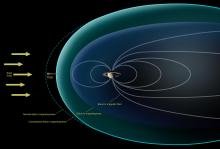Listen to today's episode of StarDate on the web the same day it airs in high-quality streaming audio without any extra ads or announcements. Choose a $8 one-month pass, or listen every day for a year for just $30.
You are here
Moon and Saturn
Big planets do things in a big way. Consider Saturn, the second-largest planet in the solar system.
A couple of years ago, astronomers tracked four storms in its northern hemisphere. They weren’t like other storms on the planet. They were bigger than the average storm, but smaller than the giants that break out every few decades — they were right in the middle. This being a giant planet, though, “mid-sized” is a whole different concept: The storms ranged from 2500 to 5,000 miles long, and lasted for up to seven months.
Saturn’s outer atmosphere is hundreds of miles thick. It’s stretched into planet-circling bands by Saturn’s high-speed rotation. The bands are colored in shades of yellow, white, and tan.
Occasionally, a storm breaks out — an explosion of water clouds driven by heat from inside Saturn. Most of the storms are hundreds of miles across. Every once in a while, though, a monster breaks out. It can stretch most of the way around the planet — tens of thousands of miles.
A recent study says the new storms could have been trying to build to giant proportions. But a monster storm a decade ago could have robbed their part of the atmosphere of energy — leaving them at mid-sized proportions.
Saturn stands to the upper right of the Moon at first light tomorrow, and looks like a bright star. The even brighter planet Jupiter is to the right of Saturn. And Mars is well to the left of the Moon. More about that tomorrow.
Script by Damond Benningfield





